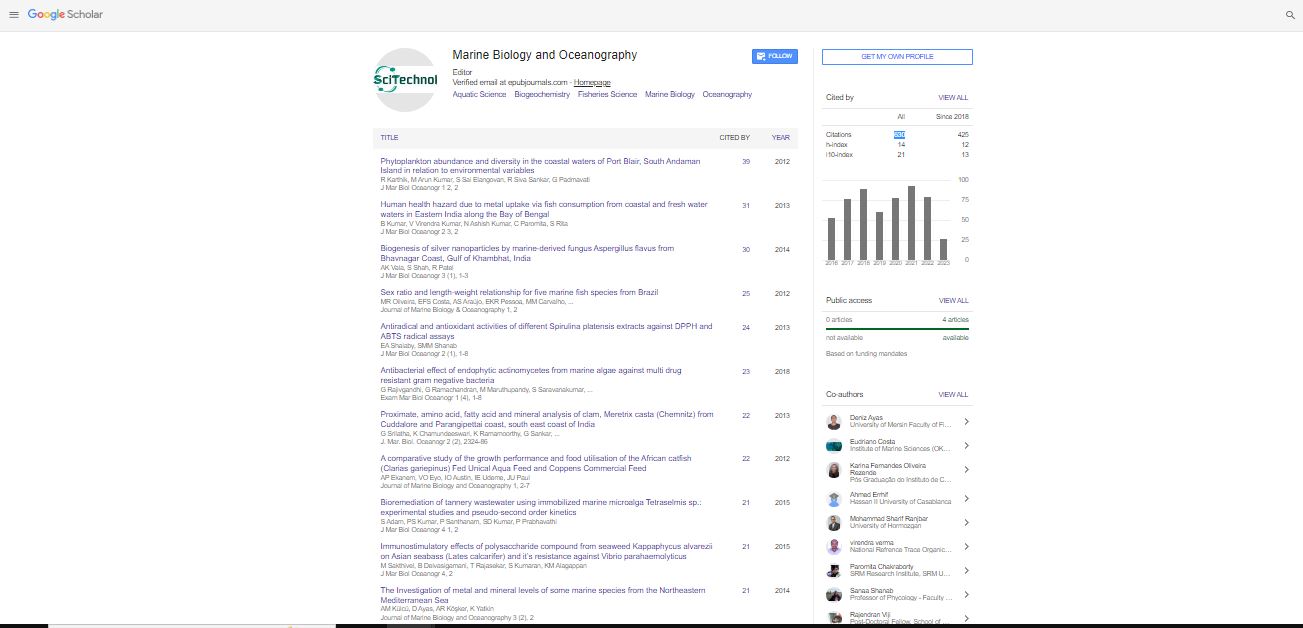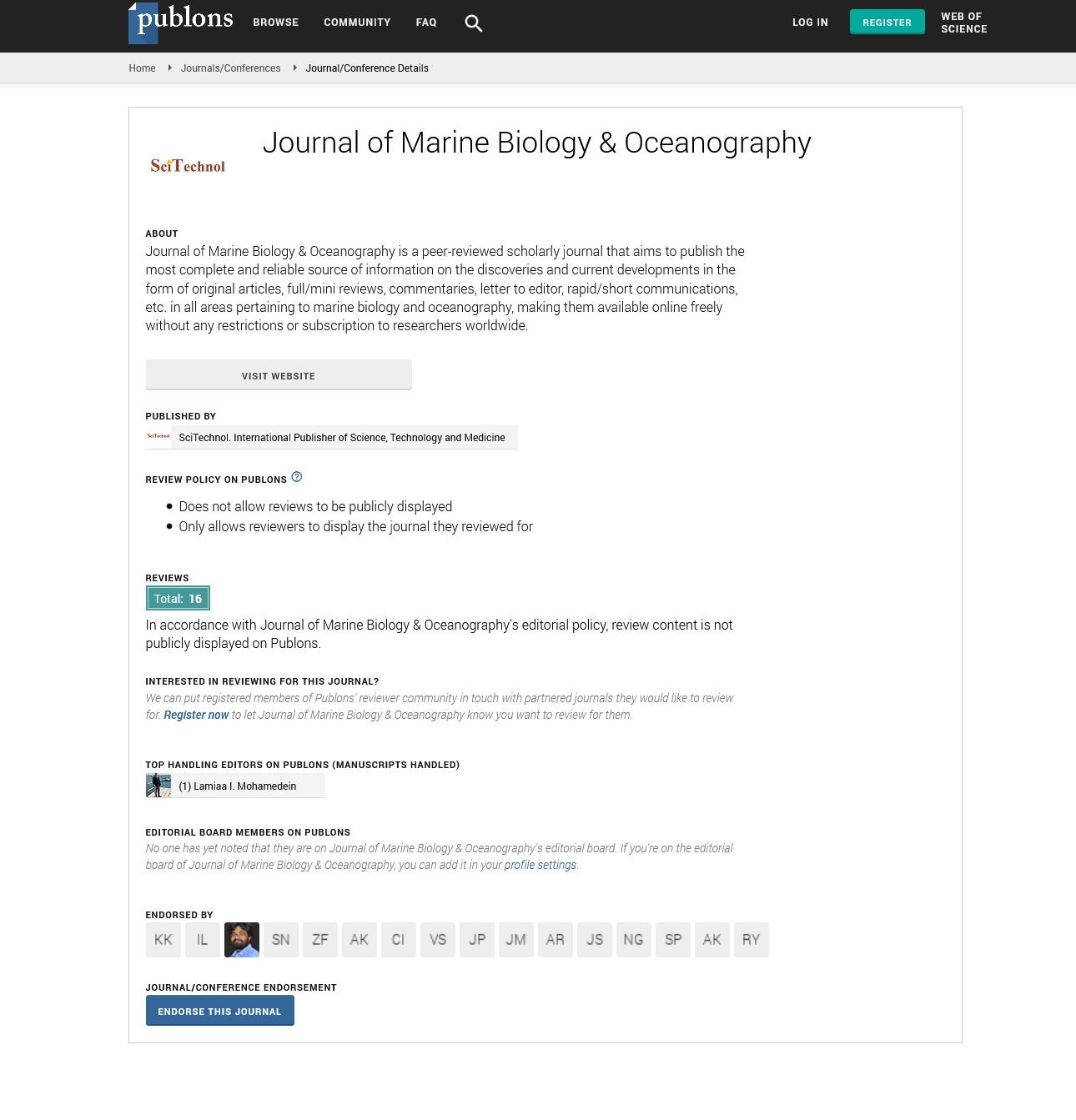Short Communication, J Mar Biol Oceanogr Vol: 12 Issue: 1
Marine Algae as a Promising Resource for Developing Antimicrobial Compounds
Chen Shao*
Department of Life Science, Tunghai University, Taichung, Taiwan
*Corresponding Author: Chen Shao
Department of Life Science, Tunghai
University, Taichung, Taiwan
E-mail: chensha@tu21.tw
Received date: 14-Feb-2023, Manuscript No. JMBO-23-91846;
Editor assigned date: 16-Feb-2023, PreQC No JMBO-23-91846 (PQ);
Reviewed date: 03-Mar-2023, QC No. JMBO-23-91846;
Revised date: 10-Mar-2023, Manuscript No. JMBO-23-91846 (R);
Published date: 20-Mar-2023 DOI: 10.4172/2324-8661.1000249.
Citation: Shao C (2023) Marine Algae: A Promising Resource for Developing Antimicrobial Compounds. J Mar Biol Oceanogr 12:1.
Abstract
Description
Marine organisms are potential sources of bioactive secondary metabolites with the potential to be used in the development of new pharmaceutical agents. Marine organisms produce a variety of compounds with pharmacological activities, including anticancer, antimicrobial, antifungal, antiviral, anti-inflammatory, and others, and are potential sources of new therapeutic agents. In a competitive and hostile environment, marine organisms survive and live within complex communities and in close association with others. The bioactive substances included alkaloids, polyketides, cyclic peptides, polysaccharides, phlorotannins, diterpenoids, sterols, quinones, lipids, and glycerols, and marine macro algae are thought to be the actual producers of some bioactive compounds with high activity. Depending on their nutrient and chemical composition, marine macroalgae are classified as Red algae (Rhodophyta), Brown algae (Phaeophyta), and Green algae (Chlorophyta) [1]. Red and brown algae, also known as seaweeds for human consumption, are an important source of bioactive natural substances. These red and brown algae have been used for centuries in Asian diets due to their natural nutritional value, which includes carotenoids, dietary fibers, proteins, essential fatty acids, and a high concentration of vitamins and minerals. Apart from their nutritional value, many Asian coastal residents prepare algae extracts for the treatment of disorders and ailments such as wounds, fever, and stomach aches, as well as the prevention of arrhythmia [2]. Seaweed bio-stimulants have been shown to have antimicrobial properties such as antibiotics, laxatives, anticoagulants, anti-ulcer products, and suspending agents in radiological preparations, making seaweeds a potential source of natural antioxidants. Bioactive metabolites such as sulfated polysaccharides, a seaweed macromolecule, and phlorotannins have also demonstrated an active response in the treatment of most bacterial and viral diseases, as well as anticoagulant properties [3]. As a result, marine algae have become an important source of pharmacologically active metabolites in the search for new drugs.
Pigments
Chlorophylls, Carotenoids, and Phycobiliproteins, are the three primary types of pigments found in marine algae, can be produced by algae as photosynthetic organisms. This allows seaweed to be classified into the Chlorophyceae (green algae), Phaeophyceae (brown algae), and Rhodophyceae families (red algae) [4]. Fucoxanthin is responsible for the colour green; chlorophylls a and c are responsible for the colour greenish brown; and Phycobilins such as Phycoerythrin and Phycocyanin are responsible for the colour red. Lysozyme, an immunological enzyme that breaks down bacterial cell walls, can accumulate as a result of the antibacterial mechanism hypothesized for carotenoids. All algae include carotenoids, which are lipid-soluble, natural colors with up to 15 conjugated double bonds and are made up of tetra-terpenoids, which are eight units of five carbons. Carotenes (where the chain ends with a cyclic group consisting solely of carbon and hydrogen atoms) and Xanthophylls or Oxycarotenoids (which have at least one oxygen atom as a hydroxyl group, an oxy-group, or a combination of both) are the two categories into which carotenoids are typically classified [5]. Carotene, Lutein, Violaxanthin, Neoxanthin, and Zeaxanthin are found in green seaweed species and carotene, lutein, and zeaxanthin are found in red seaweed and Carotene, Violaxanthin, and Fucoxanthin are found in brown algae.
Conclusion
Marine algae are one of the most important producers of biomass in the marine environment, and they could be a source of new, diverse, and unique compounds. Many seaweed-derived substances, such as alginates, carrageenan, and agar, have been used in traditional medicine, pharmacology, and food for decades. Other compounds have bacteriostatic or antibacterial properties, as well as antiviral, antitumor, anti-inflammatory, and antifouling properties. As a result, seaweed may provide promising bio actives for the treatment of human diseases, as well as new antimicrobial agents to replace synthetic antibacterial agents used in agriculture and the food industry.
References
- El Gamal AA (2010) Biological importance of marine algae. Saudi Pharm J 18(1):1-25 [Crossref]
[Google Scholar] [PubMed]
- Qin S, Lin H, Jiang P (2012) Advances in genetic engineering of marine algae. Biotechnol Adv. 30(6):1602-13
[Crossref] [Google Scholar] [PubMed]
- Moreira D, Le Guyader H, Philippe H (2000) The origin of red algae and the evolution of chloroplasts. Nature 405(6782):69-72
[Crossref] [Google Scholar] [PubMed]
- Hao Z, Iqbal (1997) Some aspects of organic pigments Chem Soc Rev 26(3):203-213
- Battersby AR (2000) Tetrapyrroles the pigments of life. Nat Prod Rep 17(6):507-26
[Crossref] [Google Scholar] [PubMed]
 Spanish
Spanish  Chinese
Chinese  Russian
Russian  German
German  French
French  Japanese
Japanese  Portuguese
Portuguese  Hindi
Hindi 
